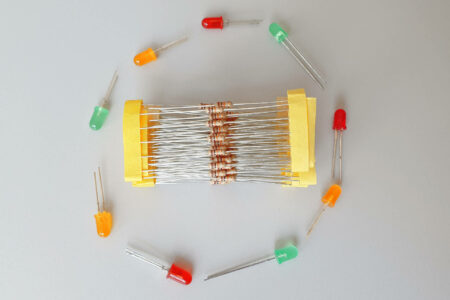A current divider is a parallel connection of resistors. The same voltage is applied across all resistors, but the current divides in proportion to the individual resistance values. Here you will find the current divider formulas as well as a simple online calculator.
Calculating a Current Divider
With a current divider, the current of a circuit can be selectively divided into multiple paths. A simple current divider consists of 2 resistors. However, theoretically, the current can be divided into infinitely many paths (resistors).
In contrast to a voltage divider, all resistors in a current divider have the same voltage across them. Only the current is divided.
Current Divider Formula
The calculation of the partial currents in a current divider is done using the current divider rule. For a parallel connection of two resistors $R_1$ and $R_2$, the current divider rule is as follows:
$$ I_1 = \frac{R_2}{R_1 + R_2} \cdot I_\text{total} $$
$$ I_2 = \frac{R_1}{R_1 + R_2} \cdot I_\text{total} $$
$I_1$ and $I_2$ are the partial currents across resistors $R_1$ and $R_2$, and $I_{total}$ is the total current through the circuit.
A significant advantage of the current divider formula is that the partial currents can be calculated solely using the resistance values (without knowledge of the voltages and so without Ohm’s law).
Current Divider with More than 2 Resistors
To extend the calculation to more than two resistors, you can use conductances instead. The conductance $G$ is the reciprocal of resistance:
$$G = \frac{1}{R}$$
In a parallel connection, the conductances add up:
$$G_\text{total} = G_1 + G_2 + \cdots + G_n$$
The partial currents can then be calculated using the conductances:
$$I_i = G_i \cdot U_\text{total}$$
where $U_{total}$ is the total voltage across the parallel connection.
Current Divider Calculator
Enter the total current of the current source and the values of the two resistances. Then the two partial currents will be calculated.
Variations of Current Dividers
The current divider presented here, which involves a network of ohmic resistors, is the most well-known and utilized form of current divider.
In addition, there are other variations such as a capacitive current divider using capacitors or an inductive current divider using coils (for alternating current).
All variations share the commonality that the total current is divided among the individual components of the network.



